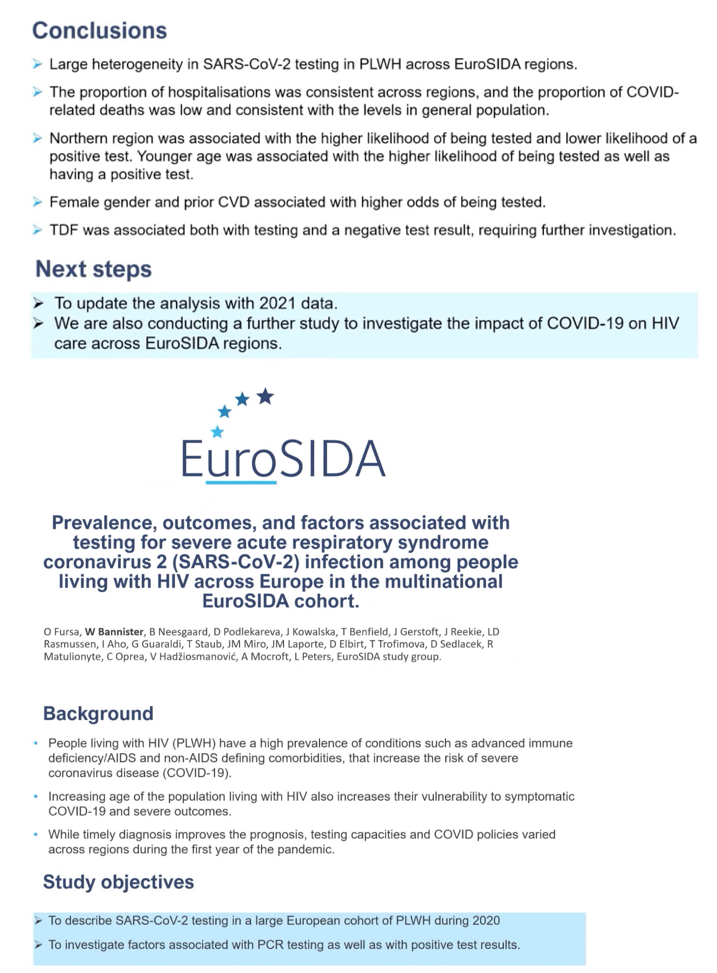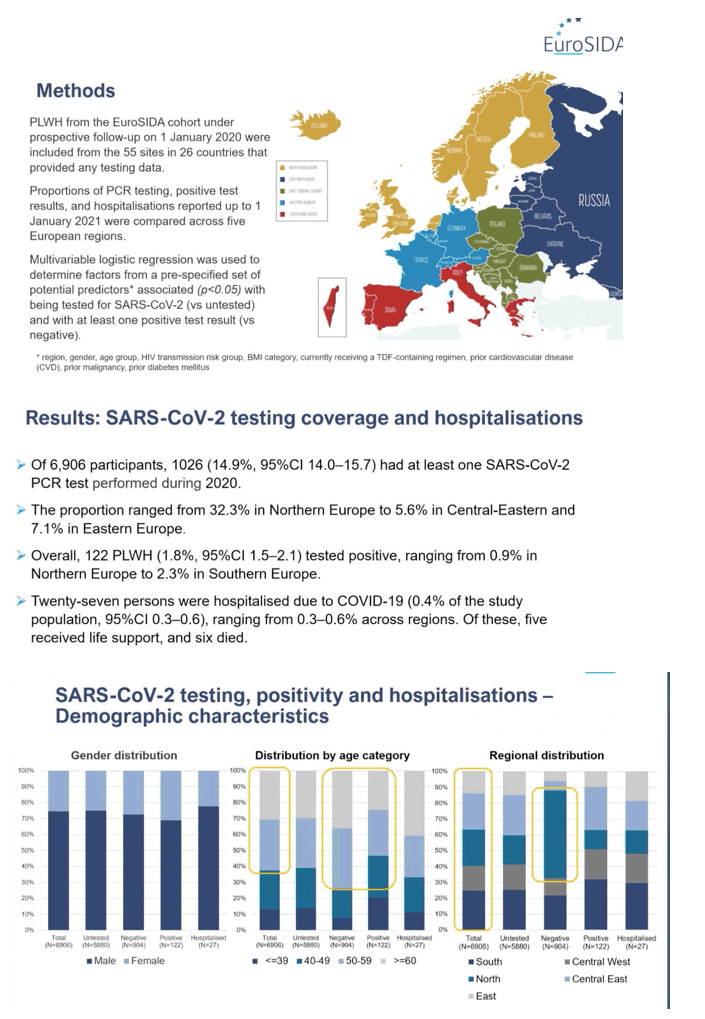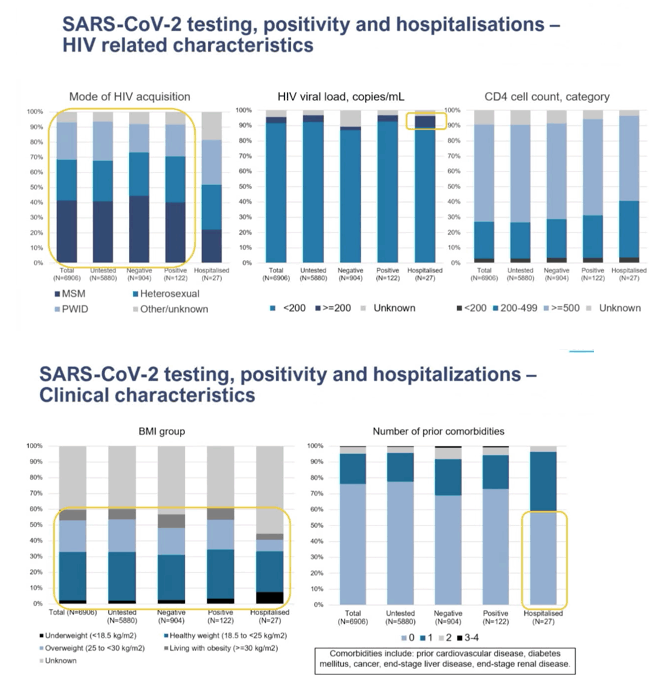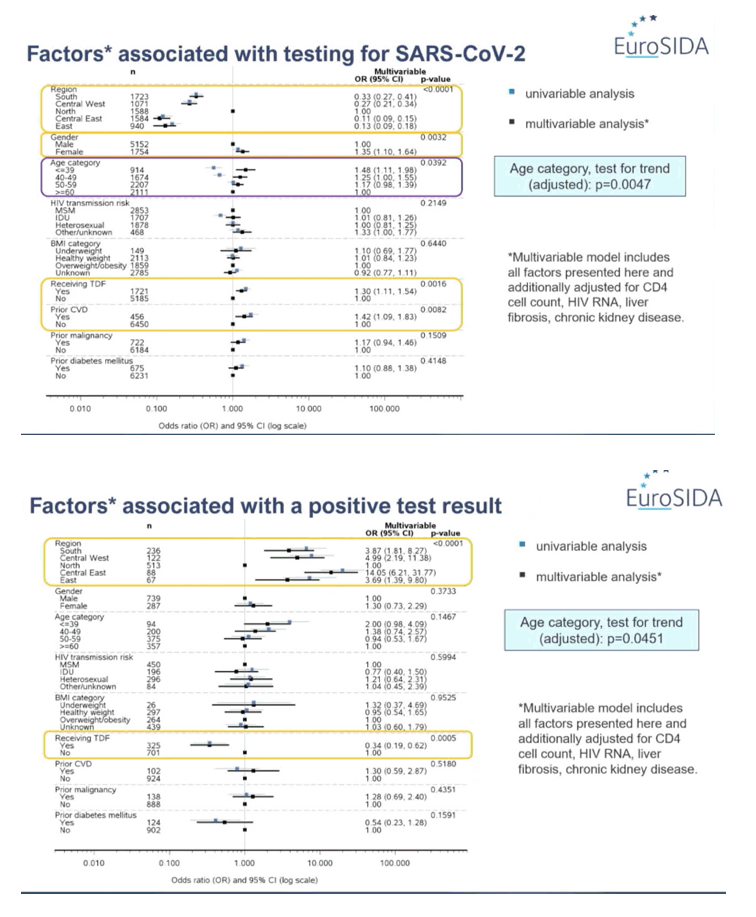 |
 |
 |
| |
Low COVID Mortality in HIV+ Europeans Similar to General Population-
COVID Testing Tied to Younger Age, Female Gender, CVD and TDF
|
| |
| |
HIV Drug Therapy Glasgow, October 23-26, 2022
Mark Mascolini
COVID mortality remained relatively low in HIV-positive people and similar to the death rate in the general population, according to a study of 6906 people in the continent-wide EuroSIDA cohort [1]. Statistical analysis linked five factors to a greater chance of being tested for COVID-younger age, female gender, prior cardiovascular disease (CVD), treatment with tenofovir disoproxil fumarate (TDF), and living in EuroSIDA's Northern region. While younger age predicted a higher risk of a positive COVID test, TDF and living in the Northern region conferred a lower positive test risk.
EuroSIDA investigators noted that people with HIV often have advanced immune deficiency or comorbidities known to boost the risk of severe COVID. As people with HIV grow older thanks to improved antiretroviral therapy, that older age paradoxically heightens vulnerability to symptomatic and advanced COVID.
A EuroSIDA team conducted this study to track COVID testing rates across Europe and to isolate factors that predicted PCR COVID testing and positive test results. They included EuroSIDA cohort members in follow-up on January 1, 2020 at one of 55 study sites in 26 countries. The investigators focused on who got a PCR test for COVID, who had positive PCR result, who got admitted to the hospital with COVID, and who died. Multivariable logistic regression to identify predictors of getting a PCR test and having positive result adjusted for a set of potential predictors: region, gender, age group, HIV transmission risk group, body mass index category, taking a TDF regimen, prior cardiovascular disease, prior malignancy, and prior diabetes.
Among 6906 participating EuroSIDA members, 1026 (14.9%) got at least one PCR test for COVID during 2020. The testing proportion was highest in Northern Europe (32.3%, Scandinavia, UK, Ireland, Iceland, Netherlands), compared with 7.1% in Eastern Europe (Russia, Ukraine, Belarus, Baltic countries) and 5.6% in Central-Eastern Europe (Poland, Czech Republic, Slovakia, Hungary, Balkan countries). Only 122 people with HIV tested PCR positive (1.8% of 6906, 11.9% of 1026).
Only 27 people (0.4% of 6906, 2.6% of 1026) got sent to the hospital with COVID; 5 of them received life support and 6 died. Men made up about 70% of people who tested either positive or negative but nearly 80% of those admitted to the hospital. Among people with a positive PCR, about 20% were 39 or younger, about 25% 40 to 49, about 30% 50 to 59, and about 25% 60 or older. Among people admitted to the hospital, only about 10% were 39 or younger, about 20% were 40 to 49, about 25% were 50 to 59, and more than 40% were 60 or older. Proportions with a viral load below 200 copies made up about 90% of the entire group. Among people in the hospital, about 90% had a viral load below 200, while a little less than 10% had a sub-200 load.
In multivariable analysis, compared with people living in Northern Europe, living in any other EuroSIDA region was associated with lower odds of getting tested for COVID. Compared with men, women had 35% higher odds of getting a PCR test (adjusted odds ratio [aOR 1.35, 95% confidence interval [CI] 1.10 to 1.64, P = 0.0032). Compared with people 60 or older, those 39 or younger had almost 50% higher odds of getting a PCR test (aOR 1.48, 95% CI 1.11 TO 1.98) and people 40 to 49 had 25% higher odds of testing (aOR 1.25, 95% CI 1.00 to 1.55).
Taking a TDF-containing combination (compared with a non-TDF combination) was associated with 30% higher odds of PCR testing (aOR 1.30, 95% CI 1.11 to 1.54, P = 0.0016). This analysis linked having a prior cardiovascular disease to about 40% higher odds of PCR testing (aOR 1.42, 95% CI 1.09 to 1.83, P = 0.0082).
Reference
1. Bannister W, Fursa O, Neesgaard B, et al. Prevalence, outcomes, and factors associated with testing for severe acute respiratory syndrome coronavirus 2 (SARS-CoV-2) infection among people living with HIV across Europe in the multinational EuroSIDA cohort. HIV Drug Therapy Glasgow, October 23-26, 2022.




|
| |
|
 |
 |
|
|